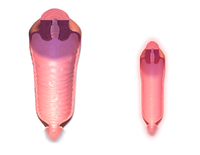
Photo from wikipedia
OBJECTIVE To assess how bone morphology and mineralization changes with age, in women by digital X-ray radiogrammetry (DXR). DXR has potential as a screening tool for osteoporosis, as it can… Click to show full abstract
OBJECTIVE To assess how bone morphology and mineralization changes with age, in women by digital X-ray radiogrammetry (DXR). DXR has potential as a screening tool for osteoporosis, as it can evaluate bone mineralization similarly to dual-energy X-ray absorptiometry. METHODS The nondominant hand was analyzed with DXR in 13,285 women ages 40-74 years undergoing mammography. 1,556 women attended two consecutive examinations with 18 to 24 months interval. Changes in bone parameters were calculated and compared in 5-year age groups. Regression analysis and ANOVA tests were performed. RESULTS Univariate linear regression showed no significant difference in age or bone size between the groups with single or consecutive measurements. In the group with consecutive measurements, the average inner diameter (DXR-ID) of the metacarpals significantly increased with age from 0.38 cm in the 40-45 years age span to 0.47 cm in the 65+ age group (P < 0.001), whereas DXR bone mineral density (DXR-BMD) decreased from 0.59 g/cm2 to 0.50 g/cm2 in the same age groups (P < 0.001). Intraindividual measurements showed a fourfold increase in yearly DXR-ID increase and concurrent DXR-BMD loss between 50 and 59 years of age (P < 0.001). The outer diameter only increased significantly between the youngest and oldest age group (P < 0.001). CONCLUSIONS The faster decrease in DXR-BMD observed during and after menopause is caused by resorption of the inner cortical surface, not matched by outer diameter increase. We speculate that most bones in the human body grow in the same pattern as observed in the metacarpals, partly explaining decreasing BMD at DXR and dual-energy X-ray absorptiometry. Video Summary:http://links.lww.com/MENO/A832.